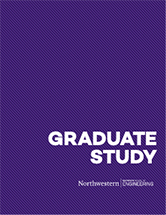How AI Can Improve Medicine
MSAI director Kristian Hammond believes artificial intelligence could help increase treatment effectiveness, reduce physician burnout, and improve healthcare access to underserved populations near and far.
Radiologists are able to do their jobs better thanks to the power of X-rays, CT scans, and MRIs that allow them to see detailed images of patients' bones and soft tissue. These physicians use their medical knowledge to identify medical problems but are limited by their own experiences and what they have seen.
What if radiologists could rely on a system that analyzed thousands or even millions of images to determine a diagnosis?
Thanks to machine learning and artificial intelligence (AI), that "what-if" is already happening. Radiologists are using AI to segment and classify images, advance diagnostic capabilities, and optimize workflow.
Kristian Hammond, director of Northwestern Engineering's Master of Science in Artificial Intelligence (MSAI) program, is not surprised to see AI playing a major role in medicine, particularly in radiology.
"One physician has a limited scope of what they’ve been able to see in the world," Hammond said. "A machine can process thousands of examples and learn to identify a range of possibilities that a human will never see."
As part of his job, Hammond keeps a watchful eye on how AI is being incorporated into a variety of professions, including medicine.
Personalized medicine is another main area of focus for AI in healthcare. Physicians and researchers can use this advanced technology to go deeper into a disease’s makeup than ever before to identify specific markers that influence how it presents in individual patients.
Those identifiable patterns will increasingly allow treatments to be customized and more effective for a targeted number of patients.
AI also could help with an issue of particular concern in the wake of the COVID-19 pandemic — physician burnout. As the virus hit in full force in 2020, burnout rates blew past 60 percent. That rate fell back below 50 percent this year for the first time since then, but that still means nearly one out of every two doctors you see is feeling some degree of overwhelming angst from being a physician.
AI could help change that by allowing doctors to do the same amount of work in less time with less effort, Hammond said.
For example, in the past, physicians would have a conversation with a patient and then spend an equal or greater amount of time transcribing that conversation into physician notes. Now, AI not only can do the transcription work for them, it can also create a real-time summary for the patient and the insurer that is distilled down to what's most important.
That doesn’t mean the physician’s role in this situation disappears. They still are vital to ensure the accuracy of the AI work.
“What it does mean is that we can do more with the same staffing, the same resources. We can do more for more people,” Hammond said. “We could increase the reach of medicine across the world, in particular in areas where we don't have doctors and we have poverty, and that's hyper-exciting.”
That reach-across-the-world impact comes through increased telemedicine from automated and semi-automated medical services. These services don’t rely on the physical presence of a physician to provide basic care currently unavailable in far-flung corners of the world — and in underserved communities right here in the United States.
This future is being crafted inside Hammond’s own program. MSAI has strong partnerships with Northwestern’s Feinberg School of Medicine. MSAI routinely welcomes residents from the medical school into each cohort — these students learn more about AI and its potential, then return to their healing profession.
“They go back with skills and an understanding of what can be done in terms of building out applications in medicine,” Hammond said. “This opens the door for a bunch of people who have really interesting, really hard, and really impactful problems to then get other students excited about looking at those problems in a different way.”
The MSAI spring practicum offers students the chance to try and solve problems sourced from across the University. Nearly half of those problems focus on medicine.
“Our students work to solve their problems, and this gives our students a tremendous amount of real-world experience,” Hammond said. “In particular, this is in environments where the data has to be protected, where at the end of the day, you could actually be saving lives and transforming medicine into a field that's completely and utterly driven by computation. That, to me, is extremely exciting.”

